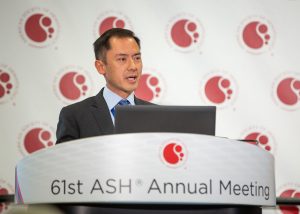
Associate Professor Andrew Wei
An oral formulation of azacitidine has been shown to improve overall and relapse free survival in patients with AML in their first remission after intensive chemotherapy.
Associate Professor Andrew Wei, head of leukaemia research at The Alfred, told the ASH 2019 meeting in Orlando that the drug known as CC-486 was the first maintenance therapy to demonstrate a statistically significant and clinically meaningful survival benefit in this patient group.
CC-486 is an oral hypomethylating agent which he said has been shown to have a distinct pharmacokinetic and pharmacodynamic profile compared to injectable azacitidine.
The QUASAR AML-001 study comprised 472 patients, from 148 sites across 23 countries including Australia, randomised to either CC-486 or placebo within four months of their first remission.
At 41.2 months follow-up, the study found an almost ten month improvement in overall survival (OS) in patients treated with CC-486 compared to placebo (14.8 v 24.7 months; HR 0.69).
Relapse-free survival (RFS) increased from 4.8 to 10.2 months with treatment (HR 0.65).
The treatment benefit was seen across key AML prognostic sub-groups, including patients older than 65 years, in incomplete remission, with poor cytogenetic risk, in the absence of consolidation therapy, and MRD positive.
Associate Professor Wei said adverse events were mostly low-grade GI side effects which were adequately ameliorated with supportive care.
Neutropenia was the most common adverse event leading to dose interruption (43% v 17%) and dose reductions (16% v 3%). However, discontinuation due to adverse events was relatively uncommon in both the treated and control groups (13% v 4%). Importantly, treatment was not associated with any detrimental effect on health-related quality of life.
There were no treatment-related deaths.
Associate Professor Wei told the meeting that although the majority of AML patients can achieve CR after intensive chemotherapy, relapse was very common, particularly in older patients and those with adverse risk factors such as poor cytogenetic risk and the presence of MRD.
“The goals of maintenance therapy are then to overcome some of these poor risk factors, reduce MRD (minimal residual disease), and improve overall survival by reducing the likelihood of relapse. The other objective of maintenance therapy is to do this without undue toxicity and to not have a detrimental impact on quality of life.”
“Based on the positive results of the QUASAR study, we conclude that maintenance therapy with CC-486 represents a new, potential therapeutic standard for patients with AML aged 55 years and older in first remission.”